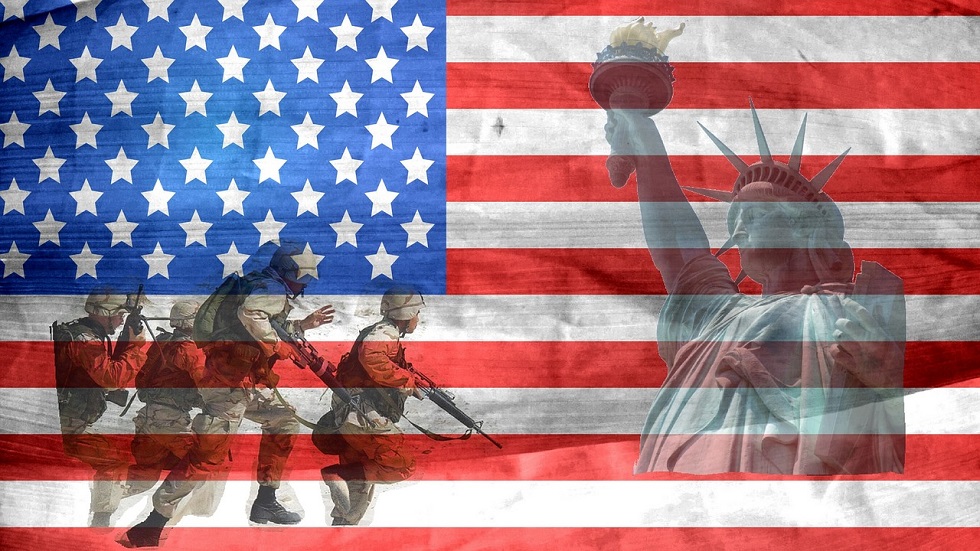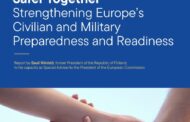Vo výbore pre vnútornú bezpečnosť americkej Snemovne reprezentantov (U.S. House of Representatives Committee on Homeland Security) sa 17. septembra 2020 uskutočnilo rokovanie venované problematike svetových hrozieb pre USA. Na tomto rokovaní vystúpil aj Christopher Miller, riaditeľ Národného protiteroristického centra. Jeho vystúpenie publikujeme v plnom znení.
* * *
Hearing before the U.S. House of Representatives Committee on Homeland Security
“Worldwide Threats to the Homeland”
Mr. Christopher Miller, Director, National Counterterrorism Center, Office of the Director of National Intelligence
September 17, 2020
______________________________________________________________________________________________________________
Opening
(U) This year, the United States and its allies have sustained pressure against key terrorist organizations, including al-Qa’ida, ISIS, and groups aligned with Iran, disrupting numerous plots and further diminishing their ability to target the United States and U.S. interests overseas. Concerning al-Qa‘ida, U.S. and French operations this year have removed the group’s long-time leader in Yemen, Qasim al-Rimi, as well as its veteran commander for North Africa, Abdelmalek Droukdal. Against ISIS, the U.S.-led coalition has continued targeting the group’s leadership cadre following the October 2019 raid that removed amir Abu Bakr al-Baghdadi, killing several prominent commanders and hampering the group’s resurgence. Finally, the United States and its allies have ramped up diplomatic, military, and economic efforts against Iran and its partners and proxies, including individuals who have conducted attacks that targeted U.S. personnel.
(U) While recognizing these successes, we also understand the challenge of translating these tactical wins into lasting gains. Time and time again, terrorist groups have absorbed similar losses only to reconstitute by exploiting local instability, adapting their tactics, and waiting out CT pressure. We need only refer to AQAP which, despite years of concerted pressure, was able to confer with a U.S.-based violent extremist who went on to kill three Americans at the Naval Base in Pensacola in December 2019, underscoring the resilience of such groups and their threat to the United States. Additionally, jihadist groups continue to stoke and harness instability in a growing number of countries, particularly in Africa, and are accruing new resources and expanding operations. Meanwhile, Iran’s intensified use of violence and militant allies to expand its influence in the Middle East heightens the overall threat to U.S. and allied interests.
(U) In the United States, we face the enduring challenge of Homegrown Violent Extremists (HVEs) inspired by the global jihad as well as the growing threat of Domestic Violence Extremists (DVEs). These lone or loosely-organized actors seek to use violence to advance a wide-range of extremist agendas, and their diffuse nature adds to the challenge of detecting and disrupting their activities. Finally, broader global trends including the COVID-19 pandemic, the rapid development of pertinent technologies including encrypted communications, and the intensifying competition for global influence, all of which may provide terrorists with new opportunities to evade authorities and carry out attacks.
Homeland
(U) We continue to assess that the preeminent terrorist threat to the United States comes from lone-actors or small cells motivated by a diverse range of ideologies. These include HVEs who have conducted three attacks this year, targeting law enforcement personnel and military facilities. DVEs have also been active, conducting three attacks against police and civilians in 2020. The majority of DVE attacks since 2018 have been carried out by Racially or Ethnically Motivated Violent Extremists (RMVEs), whose attacks have been the most lethal of DVE attacks. Some RMVEs in the United States draw inspiration from and are influenced by like-minded violent extremists overseas, who have conducted lethal attacks in at least four countries since 2018. DVEs are aggressively leveraging the online space to recruit new followers, network, and instigate violence. Many of these groups and individuals have sought to exploit and aggravate heightened societal tensions in the United States stemming from the COVID-19 pandemic and protests. My colleagues from FBI and DHS will use their testimony to expand on how these violent extremists are shaping the domestic threat environment.
(U) As NCTC’s role in joint analysis to better understand and deter DT actors has grown, we are also realigning resources to enhance our ability to detect and prevent terrorist travel to the United States. These adjustments will strengthen NCTC’s role as the national CT identity intelligence leader and further enhance our identity discovery, screening and vetting, and information sharing abilities.
ISIS
(U) U.S. and coalition CT efforts in the past year have killed prominent ISIS leaders and disrupted the terror group’s operations in several regions, but the group continues to pursue an aggressive global strategy. Following the death of the group’s leader in October 2019, the United States and its partners have successfully targeted other prominent ISIS figures including its spokesman Abu Hasan al-Muhajir and senior leader Hajji Taysir, a veteran member of the group who had overseen the group’s insurgent and global terrorism operations. In addition, the United States is working to pressure the group’s networks where they’re strongest, in Diyala and Kirkuk Governorates in Iraq, and in eastern Syria.
(U) Despite these successes, ISIS has repeatedly demonstrated the ability to rebound from severe losses over the past six years by relying on a dedicated cadre of veteran mid-level commanders, extensive clandestine networks, and downturns in CT pressure to persevere. The group has appointed a new leader, Muhammad Sa’id Abdal-Rahman al-Mawla—also known as Hajji Abdallah— and its spokesman in May trumpeted recent attacks in Iraq and Syria and promised additional operations around the world. The group has conducted a steady rate of assassinations, and IED and mortar attacks in mostly rural parts of northern and central Iraq and eastern Syria, including a series of assaults in May that killed and wounded dozens of Iraqi soldiers. These operations are celebrated in graphic propaganda videos that showcase the group’s battlefield prowess. ISIS is also working to release thousands of terror group members and their families currently detained in prisons and living in camps in northeastern Syria, where our foreign partners face growing security and humanitarian challenges.
(U) Outside of Iraq and Syria, ISIS continues to prioritize the expansion and reinforcement of its global enterprise, which now encompasses approximately 20 branches and networks. In January, the group’s chief spokesman heralded the group’s growth and pledged to expand its attacks including against Israel, echoing earlier statements made by Abu Bakr al-Baghdadi prior to hisdeath. Since last year, ISIS leaders have touted the strength of the group’s transnational network by launching five global campaigns that incorporate attack claims and propaganda videos from its branches and networks. Individually, these ISIS branches and networks have made uneven progress in advancing the group’s agenda. In several parts of Africa, ISIS groups conduct frequent attacks against local security forces and have expanded their safe havens, while coalition operations and attacks from local rivals have stunted the group’s growth in
Afghanistan, Libya, Somalia, and Yemen.
(U) ISIS continues to seek out avenues for external operations against the West, although CT pressure has diminished the group’s ability to execute operations on the scale of previous attacks in Paris and Brussels. ISIS leaders have repeatedly called on supporters in the West to conduct attacks, including attacks using toxic substances, and reiterated these calls in July in its first English-language video in 18 months since the death of the group’s last official English translator. ISIS-inspired attacks in the West have declined significantly since 2015 in part because authorities around the world continue to detain local ISIS adherents some of whom were planning terrorist attacks or attempting to join the group.
Al-Qa‘ida
(U) CT pressure against al-Qa’ida has diminished its cadre of veteran leaders and ability to strike the West, but the group’s global network still poses a significant threat to U.S. and allied interests. Al-Qa’ida’s significant leadership losses include AQIM leader Abdelmalek Droukdal in June 2020, AQAP leader Qasim al-Rimi in January 2020, the leader of AQIS in September 2019, and several senior Syria-based leaders, including deputy amir Khalid al-Aruri and Sari Shihab. However, several of the group’s remaining senior leaders continue to find safe haven in Iran, and will likely play a key role in the group’s efforts to reconstitute its leadership.
(U) Leadership losses have not diminished the group’s determination to strike American and Western targets. Through its propaganda, al-Qa‘ida leaders continue to exhort their adherents to strike U.S. persons and installations: in February, AQAP media hailed the Pensacola attack and issued a call for supporters to attack U.S. and Israeli interests around the world. Earlier propaganda lauded al-Shabaab’s attacks against U.S. military personnel in Kenya and Somalia, linking those operations to al-Qa‘ida’s global response to the movement of the U.S. embassy from Tel Aviv to Jerusalem. Al-Qa‘ida has also attempted to capitalize on global unrest and the COVID-19 pandemic in its media products and messaging.
(U) Al-Qa‘ida’s reach is sustained through its affiliate groups in Asia, Africa, and the Middle East, which continue to launch attacks against local governments, expand their territory, and look for opportunities to advance the group’s transnational agenda by striking U.S. or Western targets. In Somalia, al-Shabaab controls large parts of the country despite significant CT pressure, using these safe havens to sustain a relentless insurgent campaign against the Somali government and African Union Mission to Somalia (AMISOM) forces. Earlier this year, the group launched an attack on a joint U.S. and Kenyan military base at Manda Bay airfield and killed three Americans, highlighting the group’s external reach and determination to strike U.S. interests. Al-Shabaab also linked its attack against a hotel in Kenya in January 2019—which killed one American—to al-Qa‘ida’s global campaign targeting the U.S. and Israel.
(U) As noted previously, AQAP continues to threaten U.S. interests, underscored by its communication with the Pensacola attacker and its subsequent claim of responsibility. In Yemen, continued fighting amongst warring factions and the withdrawal of some CT forces have helped the group sustain some operations and territory despite continued CT pressure. However, the group’s ability to exploit these opportunities and expand its safe havens has been undermined by the loss of Rimi and other prominent operatives, internal tensions, and battles with other local factions, including the Huthis. In Syria, Hurras al-Din—a group made up of several alQa‘ida veterans—has suffered successive losses of key leaders and operatives, which, along with conflicts with other violent extremist factions and the erosion of its safe haven in Idlib Province, has stunted the group’s growth. As of late June, battlefield conflicts between Hurras al-din and the Nusrah Front continued to escalate prompting al-Qa‘ida to issue a public statement condemning the fighting.
(U) In North Africa, the loss of Al-Qa‘ida in the Islamic Maghreb (AQIM) leader Abdulmalek Droukdal is the latest setback suffered by the group since 2018, but it will probably continue to provide guidance to other al-Qa‘ida elements in the region despite its own lack of attacks. In West Africa, al-Qa‘ida-affiliated group Jama’at Nusrat al-Islam wal-Muslimin (JNIM) has exploited growing instability to expand its operations and carry out attacks—including a complex VBIED and indirect fire attack that killed one and wounded two French soldiers at a French military camp in Mali on 23 July—against local and Western government and security targets in the region and rivals aligned with ISIS.
(U) In South Asia, al-Qa‘ida in the Indian Subcontinent (AQIS) has struggled to rebound from the death of its leader, Asim Umar, in a U.S. military raid in Afghanistan in September 2019 and is probably only capable of small-scale regional attacks. Additionally, in mid-March, AQIS published a special issue of Nawai Afghan Jihad praising the U.S.-Taliban agreement, which mirrored al-Qa‘ida’s leaders’ statements on the deal. Finally, al-Qa‘ida’s presence in Afghanistan has been reduced to a few dozen fighters who are primarily focused on their survival, and are probably incapable of conducting attacks outside the country under sustained CT pressure.
Iran, Lebanese Hizballah, and other Terrorist Groups
(U) In addition to the global jihadist challenge, the U.S. faces a confrontation with Iran, which remains the world’s foremost state sponsor of terrorism. Tehran views terrorism as a key tool to counter U.S. influence and uses the Iranian Islamic Revolutionary Guard Corps-Quds Force (IRGC-QF)—which is a component of a designated foreign terrorist organization—to provide weapons, funding, and training to a range of terrorist and militant partners and proxies throughout the Middle East. Following the U.S. military operation that targeted IRGC-QF chief
Qasem Soleimani in January, Iranian leaders promised to take revenge and accelerate their efforts to eject the U.S. from the region.
(U) In Iraq, Tehran supports several Shi’a terrorist groups including U.S. designated FTOs Kata’ib Hizballah (KH) and Asa‘ib Ahl al-Haqq (AAH), which in the past two years have conducted an increasing number of indirect fire attacks against U.S. diplomatic installations, including the U.S. embassy in Baghdad, and military installations in Iraq, killing three Americans. These groups— which continue to received advanced weaponry and training from their Iranian backers—have pledged to exact revenge for the death of a senior militia leader in the same U.S. military operation that killed Soleimani and have pledged to force the U.S. military to withdraw from Iraq. In the Palestinian territories, Iran backs terrorist groups including HAMAS and the Palestine Islamic Jihad, which regularly targets Israel. Tehran also works with militants in the Arabian Peninsula to counter U.S. allies including Saudi Arabia and Bahrain.
(U) Iran also continues to support Lebanese Hizballah, which uses its sophisticated terrorist apparatus to advance Tehran’s regional strategy. Following the death of Soleimani, Hizballah leader Hassan Nasrallah called for retaliation including against U.S. military personnel in the Middle East, and has blamed the U.S. for the German Government’s recent ban of the group’s operations. We are closely monitoring for indications of how political and economic fallout from the Beirut explosion could impact the group’s position in Lebanon. Within Lebanon and the broader region, the group has expanded its stocks of advanced weapons systems including Unmanned Aerial Systems (UAS) and long-range rockets while deploying trainers to Yemen to train the Houthis, threatening U.S. allies. Finally, Hizballah’s global terrorist operations arm—the Islamic Jihad Organization (IJO)—has in recent years deployed operatives to almost every continent and extended its reach into the United States: since 2019, two U.S.-based individuals have been jailed for scouting potential targets on the group’s behalf.
(U) Finally, Iran continues to employ and support terrorism outside the region, potentially including the United States. In 2018, two Iranians were arrested in the U.S. for surveilling Iranian oppositionists and Jewish and Israeli groups and passing the information to Iran. In Europe, Iranian operatives since 2018 have been implicated in two unsuccessful terrorist plots in Denmark and Belgium.
Challenges
(U) I’d like to highlight and briefly discuss three broader trends that will increasingly influence the U.S. CT campaign in the coming years. (U) COVID-19 and Heightened Instability – The COVID-19 pandemic may fuel greater instability and degrade humanitarian conditions in several parts of the developing world, providing terrorists with opportunities to undermine local governments and expand their safe havens. Prior to the outbreak, terrorists groups were already enjoying success exploiting endemic instability to entrench and expand in parts of Africa and the Middle East. In these regions, local authorities often lack the capability or will to mitigate the terrorist threat, while intractable conflicts and economic instability render society vulnerable to violent extremist encroachment. The spread of COVID-19 may worsen these conditions by sapping governments’ CT and security resources and depressing local economies. Meanwhile, terrorists have recognized the potential opportunities of the COVID-19 pandemic and have accelerated attacks against over-extended security forces, used propaganda to blame the outbreak on their enemies or characterize the disease as divine punishment, and moved to undermine civilian confidence in the ability of local governments to care for civilians.
(U) Great Power Competition– Sustaining pressure against key terrorist threats amidst the intensifying contest for influence amongst major global powers will pose a growing challenge for the U.S. Increasingly, U.S. adversaries like China and Russia are expanding their military footprint and security partnerships in regions where the U.S. has critical CT equities, including Africa, Asia, and the Middle East. Both powers regularly use their overseas presence to secure new influence, attempt to diminish U.S. power, and showcase their own CT capabilities, efforts that can complicate U.S. efforts against ISIS and al-Qa‘ida. In addition, the U.S. Government’s reapportionment of resources to better meet the challenge of heightened global competition will place pressure on the CT community to prioritize high-impact strategies targeting those groups that pose the most severe threats to U.S. interests.
(U) Emergent Technologies – The CT community is moving aggressively to keep pace with the rapid development of pertinent technologies including advances in dual-use technology, UAS, 3D printing, ubiquitous end-to-end encryption, cryptocurrency, and new social media platforms, a complex challenge that demands a whole-of-government response and partnership with private industry. Terrorists have historically proven adept at harnessing these and other emergent technologies to disseminate their propaganda, attract new members, advance their weapons capabilities, and support operations, including the development of chemical, biological, radiological, or nuclear (CBRN) capabilities. Regarding social media, terrorist groups are increasingly transitioning to smaller, less-visible platforms to share content following intensified voluntary efforts by prominent companies to restrict violent and extremist material consistent with their terms of service. Terrorists are also looking to exploit the move towards greater encryption to safeguard their communications. For its part, in coordination with State, FBI and DHS, NCTC has worked with U.S. technology companies, including several members of the Global Internet Forum to Counter Terrorism (GIFCT), a private industry initiative and now a non-governmental organization, to provide technology companies with information about how terrorists use the internet, including specific key words and logos. The Center has also worked with members of the GIFCT to help identify terrorist content.
Closing
Since the Global War on Terror began nearly two decades ago, we’ve significantly degraded our terrorist adversaries and made the United States a considerably harder target for them to reach; today’s terrorism threat to the U.S. and our allies is less acute but more diffuse—emanating from more groups in more places than it did in 2001. Technological innovation, great power competition, and instability resulting from a global pandemic are only a few of the factors that will make this landscape increasingly complex in the coming year. These challenges necessitate a dynamic response that evolves along with our adversaries and applies lessons learned to adapt for the future. At NCTC, we are committed to combatting this adversary and are innovating new ways of doing business to ensure that we are best aligned to connect the dots amidst a flood of ever-changing information. What remains constant is our commitment to the mission and to supporting our partners in their unrelenting efforts to sustain pressure against terrorists and violent extremists spanning an ideological spectrum around the globe.
* * * * *
Zdroj: https://www.dni.gov/index.php/nctc-newsroom/item/2149-hearing-before-the-u-s-house-of-representatives-committee-on-homeland-security
Ilustračné foto: https://pixabay.com/sk/illustrations/veter%C3%A1n-american-nez%C3%A1vislos%C5%A5-p%C3%BDcha-1807121/







